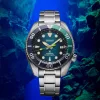BY ERIK SLAVEN
Hamilton has a rich history with American military watches. Although a Swiss company today, it was founded in 1892 as an American brand and was a principal supplier to the US military. American production ceased in 1969, but that DNA remains in its Khaki collection and the new Aviation Pilot Pioneer models are no exception. Both hearken back to a legendary pocket watch, the Model 23, and the larger hand-wound model sports a movement originally designed for pocket watches. At 38mm and 43mm for the auto and manual respectively, there’s one suitable for most enthusiasts’ wrists.
Hamilton’s military-inspired collections include field watches (such as the Khaki Field Mechanical) and pilot’s watches. As the name suggests, the Khaki Aviation Pilot Pioneer models are for pilots, but you can still enjoy them with your feet on the ground. The 43mm hand-wound variant is the most interesting and comes in two flavors, stainless steel or bronze. Specifications are otherwise identical, starting with the bold dimensions of 43mm in diameter and a thickness of 13mm. An oversized onion crown allows for use with gloves, which was vital for pilots back in the day. A double domed sapphire crystal with anti-reflective coatings protects the dial and water resistance is rated at 100 meters. As a bonus, there’s a bi-directional rotating bezel with a countdown insert. Both models come with a 20mm brown leather strap with pin buckle.
The textured black dial has what I call a skateboard grip tape aesthetic and comes with oversized Arabic numerals in old radium Super-LumiNova. The cathedral hour and minute hands are the same, but nickeled on the steel model and gold on the bronze. Both have old radium Super-LumiNova inserts. The small seconds at 6 o’clock follows the color scheme with a silver hand for the steel case and gold hand for the bronze. A classic railroad track spans the outermost perimeter. The small seconds at 6 o’clock indicates that this has an ETA 6498-1 hand-wound movement – the seconds would be at 9 o’clock with the ETA 6497. This was originally designed for pocket watches (ETA/Unitas), but has become a very popular workhorse for wristwatches – you can probably thank Panerai. It has 17 jewels, beats at a relatively slow 18,800vph and has a 50-hour power reserve.
The smaller automatic variant is 38mm in diameter with a thickness of 11.4mm, and comes with Hamilton’s H-10 caliber (based on the ETA C07.611). This one has 25 jewels, beats at a faster 21,600vph with a sizeable 80-hour power reserve. The dial is nigh identical to the steel hand-wound variant, but replaces the small seconds with a central hand. Other than size, the case is basically the same as well with an 18mm brown leather strap and pin buckle. Old radium Super-LumiNova covers the same elements and it’s a matter of wanting the large 43mm or compact 38mm case. Although I have relatively small wrists, I favor the 43mm model for the hand-wound 6498-1. It’s more traditional and old-school. The automatic does have advantages, however, such as auto-winding, an 80-hour power reserve and Nivachron anti-magnetic hairspring. The 38mm model doesn’t have a bronze option.
Hamilton is known for affordable prices and these are within reach for most enthusiasts. The 43mm model retails for EUR 1,095 or USD 1,295 in steel and EUR 1,345 or USD 1,545 in bronze. The 38mm auto is a bit less at EUR 895 or USD 995. Not exactly cheap, but well priced for what you’re getting.
Visit Hamilton here.







